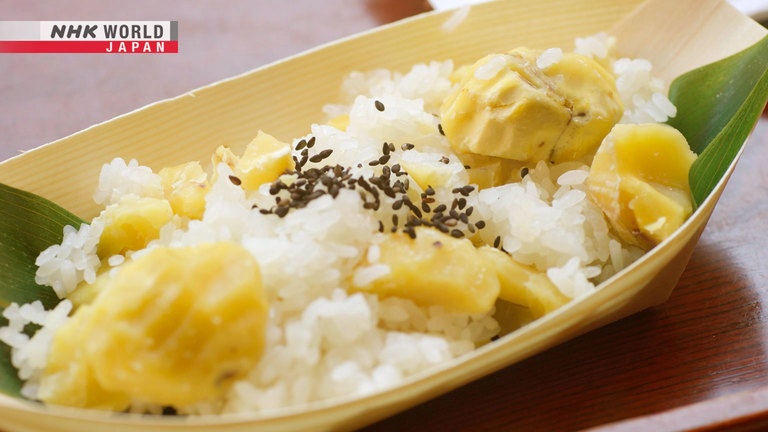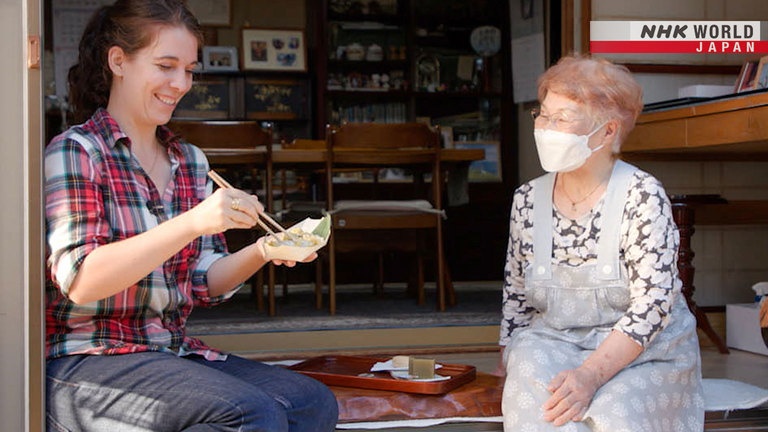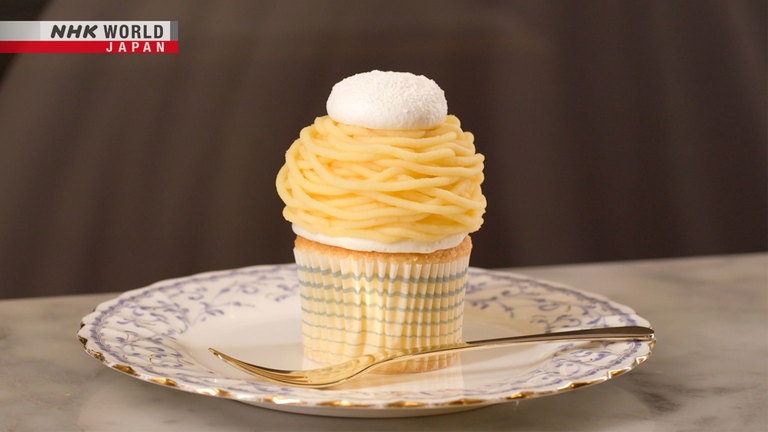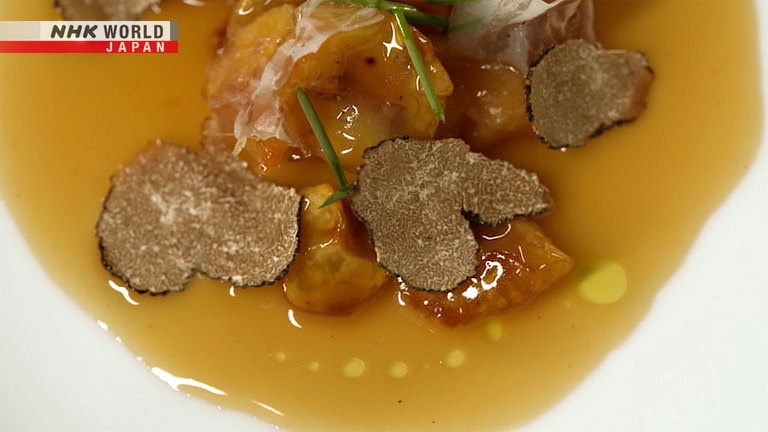JAPANESE CHESTNUT
Japanese chestnuts are known for their hearty texture, subtle sweetness, and size! Ones from Obuse are especially large. Experience a harvest there and feast your eyes on traditional "chestnut rice." We also dig into how a European dessert called Mont Blanc evolved into a uniquely Japanese delight. Explore new horizons, including French cuisine featuring fall truffles and Japanese chestnuts. (Reporter: Chiara Terzuolo)




Transcript
Tokyo: this world-class metropolis is a veritable gourmet wonderland.
Discover the stories behind the ingredients that make this city so delicious - so "oishii."
It's harvest season!
Introducing the Japanese chestnut.
With a mild sweetness and flaky texture, you can use them in both savory and sweet recipes.
Nice chestnut aroma.
Fall is here.
Eaten in Japan for over 10,000 years, chestnuts were a staple before rice was introduced.
They're often dried and preserved.
This is "kuri kinton" - candied chestnuts eaten during the New Year holidays.
With each generation comes a new heartwarming recipe.
Wow.
Enter the charming world of Japanese chestnuts.
I found Godzilla.
Trails to Oishii Tokyo.
Hi, folks. My name is Chiara.
I'm from Rome, Italy.
And today we are talking about chestnuts! Yay!
Underneath the spreading chestnut tree, I loved him and he loved me.
There I used to sit upon his knee, 'neath the spreading chestnut tree.
There are four known types.
One is the European chestnut, which is small and compact.
Chinese chestnuts are smaller, and sweeter!
American chestnuts are rare.
They have intense aroma and sweetness.
The Japanese chestnut is large and flaky, with a subtle sweetness.
Chiara begins in Obuse, an area famous for chestnuts.
In fall, the food is a major draw for tourists.
Obuse is a small town that's only four kilometers wide, but it has a ton of chestnuts.
Chiara has come just in time for harvest.
Hello.
Welcome.
I'm Chiara.
I'm Kobayashi. Thanks for coming.
My pleasure.
Meet chestnut famer and Obuse-native Kobayashi Osamu.
He quit his desk job to be closer to nature, and his favorite food.
He rented a plot of land and started his own chestnut orchard.
Shall we get some?
Please!
They fall to the ground while still in their shell.
Step on it like this, and pick up the inside.
Give it a try.
This is my first time.
Like this?
Use both feet to keep it open.
It's a bit difficult.
Wow.
It's big!
I found Godzilla.
This is 3 times bigger than ones in Italy.
I bet.
These are Tsukuba chestnuts.
They're big, with a nice balance of sweetness and strong aroma.
They're the most commonly grown variety in Japan.
Are all chestnuts in Obuse this big?
Or just here?
It depends where they're grown.
This used to be a river basin, so there
are many layers of fertile soil.
Obuse sits on a corner of land where the Matsukawa River flows into the Chikuma River.
The area has a mixture of fertile soil from the Chikuma side, and highly acidic soil from the Matsukawa side.
Acidity is important here.
This factor, provided by the Matsukawa River, is said to be what gives Obuse chestnuts their size.
Take that one.
You'll see what's special about
Obuse chestnuts when you open it.
Got it.
What do you think?
Large center.
It is. It forms one big piece.
They usually come in 3 distinct pieces.
Obuse chestnuts have a large center nut
with two small ones next to it.
I see.
It's pretty big.
Rotate it to see how plump it is.
Yeah. I'm surprised how big it is.
The outer layer is thin
but it's dense inside. Heavy.
Right.
In the area, chestnut production was apparently already underway in the 15th century.
During the Edo period, Obuse chestnuts were so highly valued, they were given as gifts directly to the Shogun.
In fact, harvest was put on hold until he got his share.
Kobayashi Issa, a prolific poet from the period, wrote about this in one of his haiku poems.
Wonderfully large Chestnuts that we cannot pick
Oh, how grand they are Why don't you try one?
Raw?
I didn't know you could eat them as-is.
We often don't. Just to have a taste.
Bite into it like this.
Great sound.
This is how we test our crop.
Interesting.
So, how are they this year?
Sweet.
Is it?
Alright, let's try this.
Oh, okay!
I see what you mean.
The sweetness comes later.
Pretty good, isn't it?
Yeah. It reminds me of something.
A simple, nostalgic flavor.
It's basically a nut, after all.
That's true. That might be it.
It's like a cashew.
Next, she'll try them boiled.
Freshly picked, they still have a strong aroma.
After boiling, turn off the heat and let them sit for another 20 minutes.
This makes them nice and soft.
They're a little hard to catch.
Oh, there we go.
Look at that! Gorgeous.
And then, you need to cut this in half.
Alright.
I'm gonna try this.
Oh, it's really good.
So, it's super moist.
And it's completely different from when they were raw, when I tried them raw.
They've got a honey scent and this sweetness that hits you immediately.
Really good.
In Obuse, many people grow their own chestnuts in the yard.
Chestnuts are all over.
The Otagiri family is no exception.
We've grown them for about 15 years.
They're pretty big.
Here's one.
Wow. These turned out great.
Right.
Time to try them in a home-cooked meal.
Thanks for having me.
My pleasure.
What are we making today?
Chestnut rice.
Here's what you'll need.
Peel chestnuts and boil them in water with salt, sake and sugar.
I rinsed the rice last night and soaked it overnight.
I see.
Now I'll steam it.
In the meantime, they'll peel the chestnuts using a special tool.
I've never seen that before.
It's a chestnut peeler. Much handier
than what we had in the past.
Is this your original recipe?
My mom's. Well, my grandma's.
My grandma made it when I was a child.
Then my mom taught me.
Now, it's Chiara's turn.
Squeeze and pull.
I'm not great with my hands.
Move forward and keep scissoring.
I see. Let's see how it goes.
There's technique involved.
Right.
That's good!
You got it.
This is kind of fun.
Picking them was fun too.
I'm not as fast as you though.
It feels good to pull off a big piece.
Did I overdo it?
Once peeled, soak them in salt water so they turn vivid yellow when cooked.
Take out the sticky rice, and add the ingredients.
Masako adds water to make it extra fluffy.
The chestnuts go in last.
Then, back in the steamer for 30 minutes.
Mix it up.
Okay!
Nice chestnut aroma.
Fall is here.
Very nice.
Enjoy.
Thank you. Can't wait.
Big chestnuts! How lovely.
Let's eat.
I hope you like it.
Fabulous.
Good. I'm glad.
The taste of fall.
Exactly.
Like eating fall!
The rice is nice and sticky.
Steaming it twice is a nice idea.
Right.
It's great with chestnuts.
They complement each other.
Great to hear.
Deep, warm flavors that expand.
I could eat this forever.
What do you like most about chestnuts?
They signal the coming of fall.
All my children have moved away,
but they come back for the chestnuts!
I look forward to cooking meals
like this for them.
This was definitely cooked with love.
Great.
I put my heart into it.
A home-cooked fall meal, packed with love.
Now, let's take a look at chestnut desserts!
These are a big thing in Japan.
Originally from Europe, recipes have evolved to better suit Japanese tastes.
Let's rewind a bit.
It all began about 90 years ago.
This is Mont Blanc. Enjoy.
How nice.
Mont Blanc - sweetened chestnut puree with whipped cream on top.
Mont Blanc? You mean Monte Bianco?
The mountain in Italy?
Exactly.
Mont Blanc is the highest peak in the Alps, a mountain range stretching across seven European countries.
The original dessert is a cake made with chestnut paste and whipped cream.
Pastry chef and avid hiker Sakota Chimao fell in love with it during a trip to Europe.
He wanted to bring it back to Japan
and share it with as many people as possible.
But in 1930s Tokyo, Western sweets weren't a thing yet.
To win the hearts of the Japanese public, Chimao turned to "kuri kinton" for inspiration.
Remember? It's the candied chestnut dessert eaten at New Years in Japan.
He took this idea of chestnuts mashed in syrup and tried making a cream instead.
He tried putting the cream on top
of chestnut paste, but the texture was heavy.
When thinking of how to make it lighter,
he had the idea to use a traditional cooking tool.
This is "odamaki."
Holes are spaced wider apart than standard cream piping tools.
This keeps the paste from sticking together, maintaining a light and fluffy texture.
The results were fantastic.
Inspired by Western techniques, a Japanese star was born.
"Mont Blanc" has become a household name, and the dessert is what comes to mind!
Looks wonderful.
"Oishii."
Thank you.
The cream and chestnuts mix to create
a nice sweetness. But not too sweet.
So smooth and light. Another taste of fall.
Ninety years and counting.
The dessert continues to win hearts in Japan.
New recipes keep popping up.
Chiara is waiting patiently for what this chef has up his sleeve.
Saoshiro Shinya squeezes out chestnut paste only when it's ordered.
He's practically an artist.
Mont Blanc prepared and served fresh - It's the ultimate chestnut experience.
I grow my own chestnuts for this.
This flavor and fluffy texture only come
when it's made fresh.
Cream loses its fluff,
and fragrance dissipates over time.
It needs to be fresh, like sushi!
Can't wait to try.
Super good.
This might be the richest
chestnut flavor I've ever tasted.
Like wine, the aroma expands in your mouth.
Aroma gets trapped in the cream's air bubbles.
When it's fluffy like this,
that aroma goes through the nose.
That won't happen if you let it sit out.
It's now or never.
Exactly.
This may explain why he grows his own chestnuts.
Everything is fresh and from the source.
He grows them naturally without relying on pesticides or fertilizers, tending to the orchard the hard way.
They're called Hitomaru chestnuts, a rare variety.
They're small with sweet and aromatic meat.
I'd say most people don't know
how chestnuts truly taste.
There's evidence of chestnut consumption
before rice was introduced to Japan.
There's a lot of history there.
I want to share its full flavor
and increase its fanbase.
Hopefully that will help preserve their legacy.
Well, you made a new fan today.
Thank you.
I'll spread the word in Italy.
There's more to life than roasted chestnuts.
There's real luxury here.
A moment to be savored, while looking ahead to a brighter future.
The final stop is a French restaurant in Tokyo.
This is Kishimoto Naoto.
Japanese chestnuts are a big part of his fall recipes too.
Today, he'll use chestnuts from Ibaraki and seasonal truffles from France.
Cooling the chestnuts for a week enhances their sweetness, and steaming them makes them even sweeter.
Sauce is an important part of French cuisine.
The base today is a white wine from Loire Valley.
He's adding chicken stock - an original recipe.
Then, a splash of vinegar.
Chilled butter thickens it and enhances flavor.
Chestnuts are broken up in advance.
This way, the edges get nice and crispy when fried, while keeping the inside soft and moist.
He fries them for about a minute.
Season with salt and pepper.
Into the sauce they go!
Thin slices of cured pork and fall truffles go on top.
It's ready.
Thanks for waiting.
Merci. How nice.
Kishimoto's very own Chestnut Fricassee - a unique mix of two worlds featuring Japanese chestnuts.
The sauce is sweet and sour, and very thick!
Doesn't that look just amazing?
Wow.
Um, so, there are no words for this.
This is incredible.
There's an amazing balance between the sweetness of the chestnut, then you got the earthiness of the truffles - and oh my goodness, I do love a truffle.
But it's all brought together by this sauce, which has this sweetness but also this sourness, the wine, and then finally the butter that brings it all together.
And it is extraordinary.
You guys should be jealous.
I keep ingredients to a minimum
to highlight the chestnut's flavor.
Chestnuts are pretty mild,
so I added a sweet and sour element.
That creates a nice balance.
What's the future of the Japanese chestnut?
European chestnuts are small with
dense flavor. They're sticky too.
Japanese chestnuts are milder with
a subtle sweetness. Quite elegant.
The more people experience their true flavor,
the more they'll be loved around the world.
Well, it's been a fantastic adventure in the world of chestnuts here in Japan.
Now, these are so different from the ones that I grew up eating as a child in Italy.
Now, they're both delicious, so I hope lots of people come and try these wonderful, wonderful nuts that should definitely be better known outside of Japan as well.
In Tokyo, every ingredient has its own story.